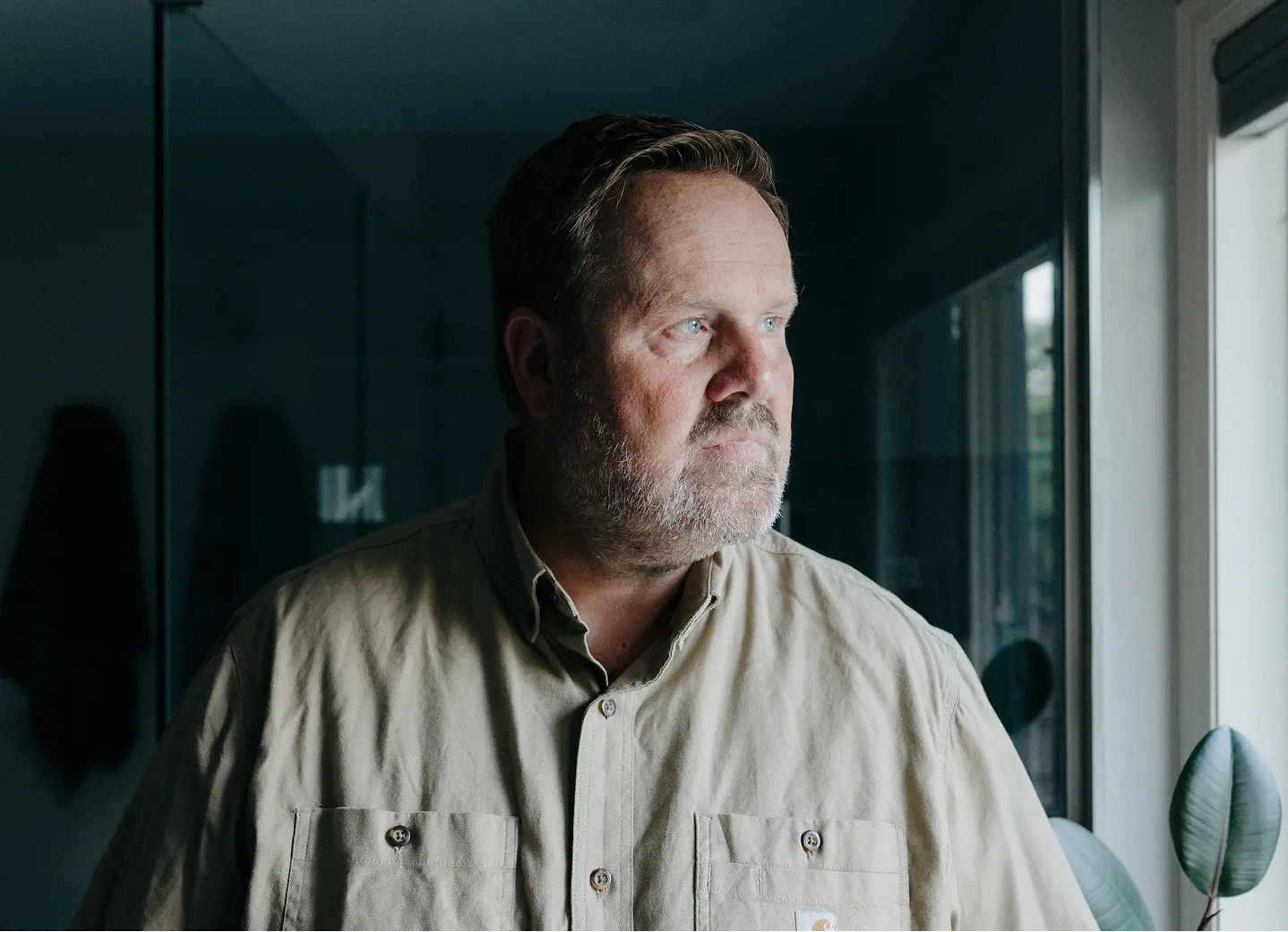If you’re timing your bathroom breaks...
maybe it’s time.
Urethral strictures aren’t rare. They’re just rarely talked about.
Optilume is the first and only FDA-approved drug-coated balloon designed specifically for urethral strictures.
Find support todayProblem
Enduring quietly.
Urethral strictures affect over 400,000 men in the U.S. every year and many go undiagnosed. At Optilume, we understand the daily struggle of urethral strictures; constantly being interrupted to go to the bathroom, the pain of self catheterizing, the silent frustration hoping for something to change.
Check your symptoms
Solution
Finding hope.
Optilume is not another temporary fix. It’s designed to treat the root cause of urethral strictures and keep them from coming back. So you can get back to life you had before your stricture, without interruptions, without worry, and without pain.
Find an Optilume Specialist
Stricture relief that lasts, backed by clinical evidence.
Optilume is not another temporary fix. It’s designed to treat the root cause of urinary stricture and keep it from coming back.
72%
Freedom from repeat intervention at 5 years 1
298%
Increase in Qmax 1
71%
Decrease in IPSS 1
Don’t just take our word for it, take theirs.
Find support todayIs Optilume® the right solution for you?
What are the symptoms of a Urethral Stricture?
- Painful urination
- Slow urine stream
- Increased urge to urinate or urinating more frequently
- A spraying or dribbling urine stream
- Straining when urinating
Find the support you need today.
 Download the Urinary Stricture treatment guide
Talk to a real person today
Download the Urinary Stricture treatment guide
Talk to a real person today(877) 841-1835
Enter your zipcode to view results
Frequently asked questions
Get answers to your questions about Optilume® and urethral strictures.
Urethral stricture disease occurs when there is an obstruction in the urethra that prevents the flow of urine and emptying of the bladder properly.
Letting these issues go on too long without seeking medical treatment can cause kidney damage, urinary tract infections and general discomfort or pain with urination.
There are two main types of urethral strictures, which include:
- Posterior stricture: These strictures occur in the first few inches of the uretha. The type of stricture is often due to injury, such as a pelvic fracture, where the urethra is either disrupted or completely separated. This makes it impossible for urine to pass, so the patient would need a catheter — a thin, hollow medical tube — inserted to allow the urine to drain.
- Anterior stricture: This type of stricture occurs in the last few inches of the urethra and is most often caused by improper catheterization or direct trauma, such as falling on an object in a straddle position.
Numerous medical and traumatic complications can lead to urethral stricture, yet 30 % of the causes1 of this condition are unknown. Here are the most common factors that lead to this issue.
Infections
Sexually transmitted infections (STIs ), such as chlamydia and gonorrhea, are among the most common causes of swelling and scarring in the urethra, creating urethral strictures.
Inflammation
Some skin conditions, such as Lichen sclerosis, create thin, white patches of skin in the genital area and lead to chronic inflammation, itching and bruising. Urinary tract infections (UTIs) can also create urethral strictures.
Medical Complications
Certain treatments and surgeries can create scar tissue in the urethra that blocks urine flow, such as irritation from long-term catheters, kidney stone removal or prostate surgery. Benign prostatic hyperplasia (BPH) symptoms or previous surgery to remove or reduce an enlarged prostate gland can lead to strictures. Inserting an instrument, such as an endoscope, into the urethra may also be a cause.
Irregularities
Some people are born with improperly formed or irregular urinary structures and genitals. One example of this is Hypospadias, which is a congenital disorder where the opening of the urethra is located on the underside of the penis instead of the tip. Adults who were born with this condition will likely have more urethral strictures.
Damage or Trauma
Injury or trauma to the genital and pelvic area can cause strictures, such as falling, damage from surgical tools or being hit in the genitals.
Cancer
Urethral or prostate cancer can create many complications, such as scarring or an enlarged prostate, in the urethra, leading to strictures. Radiation therapy treatment used to kill cancer cells in this region can also cause urethral strictures. Just over 2% of prostate cancer patients2 can experience radiation-related urethral strictures.
The urethra acts like a garden hose. Where there is a blockage or narrowing in the hose, the flow of water is restricted. If you or a loved one has a narrow enough stricture, you or they will experience various symptoms, such as problems with urinating, pain or infections. A severe blockage that goes untreated for a long time can lead to kidney damage.
In some cases, people with urethral stricture may not exhibit any symptoms. However, it’s common to experience a range from mild discomfort to extreme pain to complete urinary retention. Other common symptoms of urethral stricture include:
- Painful urination
- Slow urine stream
- Frequent UTIs
- Increased urge to urinate or urinating more frequently
- Blood in the urine
- Urethral discharge
- Swelling of the genitalia
- Loss of bladder control
- Abdominal pain
- Dark urine
- A spraying or dribbling urine stream
- Incomplete bladder emptying
- Straining when urinating
There are several ways for doctors to determine whether you have a urethral stricture, such as by conducting a physical exam or using ultrasound and X-rays to produce images of the urethra to locate the blockage. Doctors can also use a urinalysis (UA), urine culture or urethral culture to determine if you have a urethral stricture. Imaging and endoscopic examinations are often necessary to determine the cause of this condition.
Two other common procedures for urethral strictures are a urethroscopy and a retrograde urethrogram.
Urethroscopy
In this procedure, a urethroscopist will insert a small, lubricated urethroscope into the urethra. This urethroscope has a very small camera attached to the end of the bendable or rigid probe. As the doctor moves it up the urethra, they are able to see the narrowed area and assess the structure and function of the urethral sphincter.
The urethroscopist can also use a flexible cystoscope to analyze the anatomy of the bladder to rule out abnormal conditions. A urethroscopy is done in a doctor’s office and allows them to decide the best treatment option for the stricture.
Retrograde Urethrogram
A retrograde urethrogram is used to determine more details about strictures, such as how many there are, their length, severity and position. This outpatient procedure uses contrast dye, which is a fluid that doctors can see on X-ray imaging, by inserting it into the urethra without the use of catheters or needles. The dye allows the doctor to see the entire urethra on the X-ray machine, which helps them locate the narrowed area.
The term “retrograde” in this procedure refers to “against the flow” of urine, which can be combined with an antegrade urethrogram, meaning “with the flow” of urine. This combination involves inserting dye from above and below the bladder or urethra to help doctors find the gap of the stricture so they can plan for surgery. This procedure can also be used to identify strictures if there has been trauma to the area by injecting the dye through a catheter that doctors place for healing.
People suffering from urethral strictures often need to undergo one or more treatment options, which can be surgical or minimally invasive, to avoid a worse issue. Urinary or testicular infections could develop, such as kidney stones, if left untreated. Likewise, excessive urinary retention can cause an enlarged bladder and other kidney problems.
Below, we’ll discuss some treatment options for urethral strictures as well as some benefits and considerations of each.
Intermittent Self-Catheterization
Intermittent self-catheterization (ISC) for urethral stricture allows patients to empty their bladders if they have difficulty or discomfort when
urinating. As the term suggests, this patient performs this procedure themselves. This treatment involves inserting the thin, hollow catheter into
the bladder through the urethra so urine can drain through the tube into the toilet or container.
Once the bladder is empty, you remove the catheter and repeat at regular intervals during the day. Some people may need to complete this method four to six times a day or every few hours depending on how fast the bladder fills up.
Intermittent self-catheterization can keep the scarred area of the urethra from narrowing, but this method can be painful or time-consuming and requires a constant supply of catheters. Additionally, inserting catheters too often or having them in too long can risk introducing bacteria into the body and lead to infection, scarring, UTIs, spasms or perforations.
Urethral Stricture Dilation
Standard dilation for urethral stricture is another common type of treatment. This outpatient procedure involves general or local anesthesia and is
performed by a urologist. The treatment involves stretching the narrow stricture tissue out using rod dilators that increase in diameter, or a dilation
balloon inserted by a catheter. While this solution is a non-surgical treatment option for urethral stricture disease, some patients may find it’s only
short-term.
Sometimes, the stretching method must be repeated regularly. If the stricture comes back too quickly, patients may have to learn how to perform the urethral dilation at home with lubricating gel, anesthetic gel and rods to prevent it from coming back. However, if the stricture is small or short, it’s less likely you will need to get the procedure done again. Some side effects of this procedure include infection, bleeding or the creation of a second “false” urethral channel due to stretching.
Optilume® Drug Coated Balloon Dilation
Optilume is the world’s first drug coated balloon approved by the FDA to treat patients with Urethral Strictures. The Optilume Urethral Drug
Coated Balloon technology simultaneously dilates and delivers an anti-proliferative medicine to the urethral stricture.
During the Optilume procedure, The Optilume device expands the scar tissue surrounding the urethral stricture creating a dilation and micro- fissures across the affected area. This allows the drug, paclitaxel, to be delivered directly to the stricture. This combined technique results in limiting scar tissue generation and helps prevent future stricture recurrence.
Optilume® is proven to provide superior results compared to the standard of care for endoscopic management. The ROBUST III Randomized Controlled Clinical Trial showed that 83% of patients remained free from re-treatments for their urethral stricture 1 year after their Optilume procedure. 5 A doctor can consult with you to determine your best treatment option. Contact us to find a full list of Optilume® providers.
Urethrotomy
Internal urethrotomy for urethral stricture uses a special scope that moves along the urethra to locate the stricture. This treatment is often an
outpatient surgery that involves cutting the stricture to create a gap using a laser or knife blade at the end of the cystoscope.
Once the stricture is cut open, the bladder is emptied through a catheter and filled up again with irrigation fluid, which is drained afterward. To let the opened stricture heal, the surgeon will often place a new catheter to hold the gap open and remain in place for a certain length of time depending on the length or severity of the stricture.
Short-term (less than six months) success rates for internal urethrotomy are about 70% - 80% 3 and will often increase after the five-year mark if there’s no recurrence.
Urethroplasty
Urethroplasty is an inpatient surgical treatment option with an average stay of about 2.5 days4. Urethroplasty for urethral stricture is a
reconstructive procedure that consists of two main types: anastomotic urethroplasty and substitution urethroplasty.
1. Anastomotic Urethroplasty
Usually reserved for short, minor urethral strictures, this method involves cutting between the scrotum and rectum and reconnecting the urethra
to remove the stricture. This surgery can be either inpatient or outpatient and requires a catheter for up to three weeks and an X-ray image after
removal to ensure the repair is healed.
2. Substitution Urethroplasty
For longer or more severe strictures, this surgery involves transferring tissue to replace the area where the stricture was. This procedure may be
inpatient or outpatient and can consist of repairs in several different stages, including:
- Free graft: This process involves enlarging part of the urethra using the patient’s own tissue. This inpatient procedure may require skin from another part of the body and a two to three-week use of a catheter after.
- Skin flap: This option involves rotating flaps of skin from the genitalia to create a new section of the urethra for a severe stricture. This is an inpatient procedure that also requires catheter use for a few weeks.
- Staged: When local tissue cannot work for a free graft or skin flap, this option involves securing a graft to the opened urethra and letting it mature and heal over time until it becomes soft and flexible.
While these surgeries often produce long-lasting results, potential complications and side effects include erectile dysfunction and penile curvature.
Benign prostatic hyperplasia is a non-cancerous enlargement of the prostate gland, which can lead to urinary symptoms such as frequent urination, weak urine flow, and incomplete bladder emptying. It occurs due to the natural aging process and hormonal changes, particularly an increase in levels of dihydrotestosterone (DHT).
There are various treatment options available, ranging from medication to minimally invasive procedures and surgery. Optilume® BPH Catheter System is a minimally invasive procedure with quick recovery time, and immediate symptom relief that is durable. Men experiencing BPH symptoms such as frequent trips to the bathroom and the urgent need to urinate should contact their healthcare provider to see if Optilume® BPH is an option. Visit our Find A Provider tool to find a local Optilume® BPH trained physician.
- Source 1: https://www.medicalnewstoday.com/articles/324983
- Source 2: https://www.frontiersin.org/articles/10.3389/fsurg.2021.635060/full
- Source 3: https://www.verywellhealth.com/urethrotomy-4174265
- Source 4: https://www.ncbi.nlm.nih.gov/pmc/articles/PMC6995930/
- Source 5: https://pubmed.ncbi.nlm.nih.gov/34854748/
Request more info about Optilume®
Sign up for educational emails about urethral stricture and how Optilume® can help treat urethral strictures. Click below to talk to a real person about treatment options and to learn more.
Talk to a real person today(877) 841-1835



